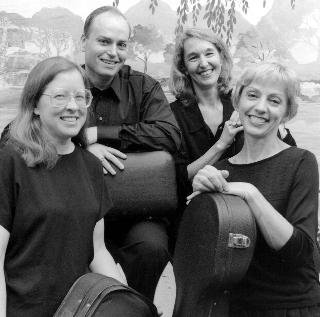Left Bank Concert Society
 On Saturday night, the Left Bank Concert Society gave an interesting and very good performance at the Clarice Smith Performing Arts Center in College Park. Now in its second season, the LBCS was formed by members of the Theater Chamber Players and champions music by contemporary composers, a cause that is sure to receive sympathy here at Ionarts. The members of the Left Bank Quartet opened the program with the youthful op. 3 string quartet of Alban Berg. They gave a performance full of appealing effects -- croaking staccato notes and odd scraped harmonics -- that put the first movement (Langsam) on the macabre side, at points like a dance for dusty skeletons. The quartet continued with a good sense of rhythmic élan in the second movement (Mäßig Viertel), where the music is much more explosive, with metallic tremolos and a rather memorable ending.
On Saturday night, the Left Bank Concert Society gave an interesting and very good performance at the Clarice Smith Performing Arts Center in College Park. Now in its second season, the LBCS was formed by members of the Theater Chamber Players and champions music by contemporary composers, a cause that is sure to receive sympathy here at Ionarts. The members of the Left Bank Quartet opened the program with the youthful op. 3 string quartet of Alban Berg. They gave a performance full of appealing effects -- croaking staccato notes and odd scraped harmonics -- that put the first movement (Langsam) on the macabre side, at points like a dance for dusty skeletons. The quartet continued with a good sense of rhythmic élan in the second movement (Mäßig Viertel), where the music is much more explosive, with metallic tremolos and a rather memorable ending.
The LBCS mission to perform the most current music possible led violinist Sally McLain toward Axon, a piece by Cuban-born American composer Tania León for violin and interactive computer, from 2002. The original form of the piece called for the live violin part to influence the sonic output of a listening computer. Ms. McLain explained before her performance that "technical difficulties" had scuttled that plan. She chose instead to give us one of the other two arrangements advanced by the composer, with violin accompanied by a tape of prerecorded electronics. The major appeal of the piece appears to have been the possibility of a computer actually interacting with a live musician. Without that element, the work struck me as a collection of interesting motifs -- arpeggiated figures, rasping belchs, runs -- and a soundtrack of world musicish percussion and chanting, all of which didn't add up to much, in spite of Ms. McLain's excellent playing.
Left Bank Ligeti (May 9, 2005) New Sounds over the Potomac: The Left Bank Concert Society is Here! (October 20, 2004) Tōru Takemitsu Concert at the Library of Congress (October 9, 2005) |
The best piece on the program, in my opinion, was the selection of pieces -- only those that featured solos or combinations of violin, viola, and cello -- from György Kurtág's Jelek, játékok és üzenetek (Signs, Games, and Messages, 1989-1997). The bagatelle sort of piece was a recurring theme in Kurtág's career, dating from his early commission of simple pieces for children. We heard all three players amusing themselves, according to the composer's instructions, with a sotto voce Lydian scale fragment, tone bends, Doppler crescendi and decrescendi, pizzicato effects, and folksong evocations, all very effective. For the second half, two string colleagues -- violist Doris Lederer and cellist Clyde T. Shaw -- joined the quartet for a tribute to early music, that is, Johannes Brahms's op. 36 string sextet in G major, from eons ago, back in 1865.
Frankly, I have never cared much for this sextet's first movement (Allegro non troppo), which contains the very uncharacteristic -- for Brahms -- use of a motif spelling out the first name of Agathe von Seibold, a woman with whom Brahms broke off his engagement to marry. In this performance, too, I was much more taken with the second movement (Scherzo, allegro non troppo), with its folkish but contrapuntal scherzo and particularly raucous waltz trio. The six players sometimes clashed in minor ways in terms of intonation, and there was an omnipresent percussive noise from one or two players' feet tapping. This was a fine end to a very good concert, with the 9/8 last movement (Poco allegro), which in its Gigue-like qualities, seems to be a tribute to the suites of Bach in some way.





















































No comments:
Post a Comment